back to WRITINGS
The Sky-scraper revitalized: Differentiation, Interface, Navigation
Patrik Schumacher, London 2006
Published in: Zaha Hadid, Exhibition Catalog, Guggenheim Museum Publications, New York 2006
Zaha Hadid Architects are entering a new phase of expansion, taking on larger projects and venturing to design towers. The precise (built) implications of this venture have yet to be seen. Is Zaha Hadid going mainstream or is the sky-scraper finally succumbing to the pressure of absorbing the lessons of the avant-garde?
What is currently on the drawing boards seems to suggest that this encounter is not a loosing battle, but the beginning mutation of a hitherto ultra-stable typology.
Zaha Hadid started by injecting a new level of dynamism into architecture. Her work has been explosive, fluid and boundless - forcefully questioning the need for urban fortifications in her drive to establish a continuous, active ground-plane. The fragments of the exploded built volumes were drifting across this agitated ground, seemingly defying gravity.
Behind this spatial exuberance lies the real need to organize multiple, dynamic programmes within dense urban contexts. This leads to the rejection of closed forms and to the adoption of open-ended strategies of networking and layering. The horizontal was always the primary expansive dimension of this new dynamism. The Hong Kong Peak - metaphorically flipping the Hong Kong towers to generate a horizontal cluster of beams - was the paradigmatic project of this first wave of work. The Vitra Firestation, the Duesseldorf Media-centre and the Cardiff Opera House are further well known early examples.
Coping with complexity
Following on from these early manifesto projects Zaha Hadid Architects contributed to the collective avant-garde effort to forge a new fluid and adaptive language of architecture that responds to the increased levels of social and urban complexity.
Contemporary urban life is becoming ever more complex, with divers, overlapping audiences, with multiple, simultaneous demands. Dense proximity of differences, and a new intensity of connections distinguishes contemporary life from the modern period of separation and repetition. The task is to order and articulate this complexity in ways that maintain legibility and orientation.
To meet this challenge a new architectural language is emerging that is inspired by (organic and inorganic) natural systems. This new language flourishes via the new digital modeling tools that have augmented the design process with techniques of continuous form-variation. This approach privileges curvelinearity and allows to fuse multiple trajectories into a coherent texture.
The Central building for the BMW plant in Leipzig and the Science Museum “Phaeno” in Wolfsburg might be cited as prime built examples of this new architectural language. The National Italian Museum for Art and Architecture of the 21st Century “MAXXI” in Rome, and the new fast train station for Naples-Afragola are further examples currently under construction. All these examples follow horizontal trajectories, mostly with the tendency to mesh with their context rather than standing apart as clear and distinct objects.
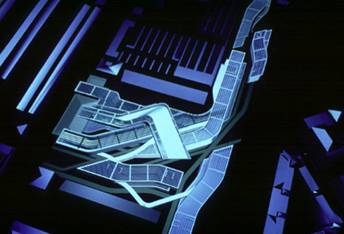
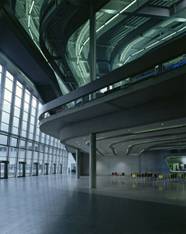
MAXXI, Italian Museum for 21st Century Art Central Building, BMW, Leipzig
Toppling the modernist Tower
Against this story of contemporary social and architectural fluidity stands the stiff, solitary figure of the skyscraper. Once the penultimate architectural symbol of modernism, the skyscraper seems locked in the bygone fordist paradigm of segregating segmentation and serial repetition. The tower typology is the last bastion of this bygone era, and has so far consistently resisted the injection of any significant measure of complexity.
Towers are still driven by pure quantity. Their volume is generally generated by pure extrusion and their inner space is nothing but the multiplication of identical floor-plates. They are vertical dead end corridors, usually cut off from the ground-plane by a podium. All this is like this for good economic reasons, but there are equally valid reasons why it might be time to tackle the tower typology armed with the new concepts and ambitions of our new architectural language.
We had resisted the design of towers for a long time. If we had to go high, we much preferred the slab with its lateral extension giving more room for spatial manipulation. We had experimented with bent slabs (Victoria Areal Competition, Berlin 1988), twisted slabs (Hamburg Hafenstrasse, 1989), clusters of slabs (Duesseldorf, 1990), and a split slab (Competition for a hotel in Abu Dhabi, 1993). In 1994 we finally designed a tower for the first time - for a mixed use development on Manhattan’s 42nd Street. We avoided extrusion, repetition and hermetic curtain walling and instead proposed a vertical pile of interlocking blocks, differentiated with divers external textures and interstitial spaces. On the inside we enthusiastically jumped on John Portmann’s fantastic innovation of a super tall atrium surging up the tower. John Portmann’s invention is the only notable innovation concerning the organisation of towers in the 2nd half of the 20th Century, and the interior space of his hotel tower on Times Square remains the most inspirational space for me in all of New York.
In retrospect our 42nd Street tower design seems both prophetic and primitive. It was the first tower design that proposed a radical differentiation of the tower along its vertical axis and did so both from without and within. Portmann’s idea of the atrium was radicalised into a rhythmically animated navigation-space that gave interest and orientation to the upward journey. Our design was primitive (by current standards) with respect to its collage mode of differentiation by mere juxtaposition. Also, its mode of interfacing with the ground was not developed.
We lost this competition and it was only in the aftermath of 911, in the context of speculations about how ground zero and lower Manhattan could be elevated once more, that we made a fresh start to investigate the potential of the tower typology once more.
We were brain-storming and preparing speculative design sketches.
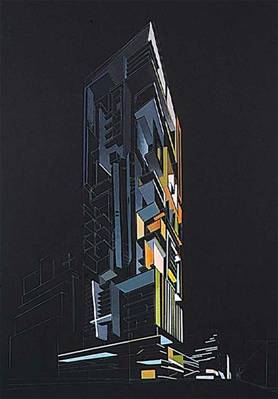
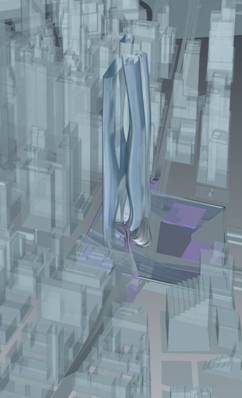
42nd Street Tower, NYC Ground Zero Tower, NYC
After 911 - Metropolis beyond the skyscraper?
New York’s World Trade Center was designed in the mid-to-late sixties, at the peak of the era of Fordism - the system of assembly-line mass production that led to modern mass society. Standardization, grids, series, and the endless repetition of the same was all around. The serial aesthetic of Mies van der Rohe’s American period was the most pertinent expression of Fordism in architecture. Yamasaki’s twin towers developed this principle to its ultimate symbolic conclusion: Even such an enormous structure like the great American skyscraper could be subordinated to the principle of repetition as if it was an item for mass production.
The tragic destruction of the World Trade Center raises the question of what could replace it. What kind of organizational structure would satisfy contemporary business and life processes, and what kind of formal language would best articulate the new era?
The epoch of the repetitive skyscraper is over because the sky-scraper’s organizational structure is too simple and too constricting. Towers only grow in one dimension. The strict linearity of its extension accounts for its characteristic poverty of connectivity. Towers are hermetic units, which are themselves arrays of equally hermetic units (floors). These features of linearity and strict segmentation are anti-thetical to contemporary business relations as well as to contemporary urban life in general. Much higher levels of complexity are required to spatially order and articulate contemporary social relations.
However, the demise of fordism and of the skyscraper as its urban archetype does not imply the retreat from the large scale nor from high density. Both bigness and density are increasing within the contemporary metropolis.
Our sketch design for a new ground zero tower was proposing a bundle tower whereby the different tubes or fibres of the bundle were emerging from different horizontal trajectories that we had identified within the site. Thus we had conceived a strong compositional device to interface the tower with the complex ground configurations. The filaments turned into the vertical and their shifting relative size and interplay afforded a mechanism to achieve the continuous differentiation of the tower along its vertical axis. The modulated space between the filaments of the bundle was exploited as orienting navigation space. Further, the possibility of mutual stabilization of the tubes means that the tower can reach a considerable height without imposing a dark and deep interior.
This year we have exploited this concept of the bundle once more for our proposal of “Dancing Towers” in Dubai. The project is supposed to mark the centre of a series of concentric rings of towers that are currently promoted as Business Bay Dubai. Here we interpreted the mixed use high-rise development by means of three towers - an office tower, a hotel tower, and a residential tower - that variously converge and diverge, meet and separate to share a ground lobby as well as a sky-lobby above the midpoint.
The filaments of this bundle spread out in various directions on the ground, generating both additional ground surfaces (for lobbies and retail areas) as well as connections into the context. One of those horizontal extensions is establishing a habitable bridge link across the creek.
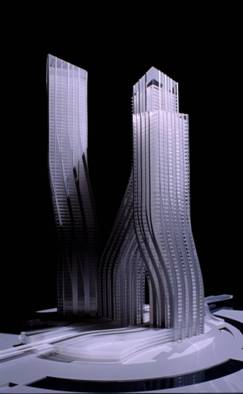
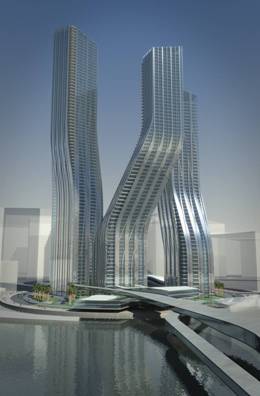
Dancing Towers, Business Bay, Dubai
Compressed Complexity and Parametric Interarticulation
These first examples cited above start to demonstrate that the new architectural language can offer a new lease of life to the tower typology.
What is of particular interest to us is also the reverse effect: The disciplining effect of the task to design a high-rise on the architectural language we are trying to develop and refine. The tower demands much higher levels of precision and a close knit integration of all parts and subsystems. This shifts the emphasis of the new language of architecture away from the freewheeling, expansive layering to towards a keen sense of compact inter-articulation. This implies tight geometric coordination of all components. If the principles of variation, adaptation and differentiation are to be upheld we require a new set of concepts and tools. The geometry of the building has to be conceived as network of linked parameters and handled with an elaborate parametric models, whereby e.g. the internal subdivision is linked to vary simultaneously with the changing outer shape of the model. The structure should adjust with increasing height etc.
The designs of our towers for Beijing CBD, Milan, and Marseilles were generated by means of such a parametric models.
The parametric modeling affords a new, concrete understanding of “organic” design as parametrically controlled inter-articulation of the subsystems.
As scripted system of relations the parametric composition is highly differentiated, yet this differentiation is rule-governed. It is based on a systematic set of lawful correlations that are defined between the differentiated elements and subsystems. These correlations integrate and (re-)establish a visible coherence and unity across the differentiated system. It is the sense of law-governed complexity that assimilates this work to the forms we find in (organic as well as in inorganic) natural systems, where all forms are the result of lawfully interacting forces. Just like natural systems, parametric compositions cannot be easily decomposed into independent subsystems – a major point of difference in comparison with the modern insistence on clear separation of functional subsystems, like tower and podium, skin and skeleton, post and beam etc.
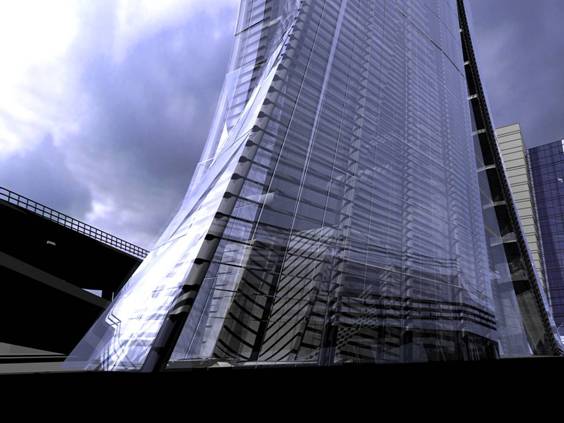
Headquarters CMA CGM, Marseilles
A new high-rise paradigm: 3 critical agendas
In the following I would like to present our current tower designs alongside the manifesto-style slogans that we would like to promote as key concerns and ambitions we believe to be relevant to formulate a new high-rise typology and a new paradigm for the design of towers.
1. Differentiation
The most general slogan and overall headline for a new approach to the design of towers would be: Injecting complexity. While all the points below may be subsumed under this general headline, it is the differentiation of the mass of the tower that is the most obvious aspect. All of our towers avoid platonic footprints and extruded volumes. The exterior expression of the tower as a bundle (Dubai Business Bay), stretched ovoid (Beijing Soho City, NY Olympic Village), wave-shaped tall slab (Moscow), stretched prism (Marseilles), or stretched spiral (Milan), blade (Durango) ect. gives each tower a different recognisable shape. However, it is not so much the icon that we are after, but we seek to shape an asymmetric, differentiated volume that offers a certain variation of conditions and spaces on the inside as well as affording opportunities for urban contextualisations: We are proposing differentiated volumes that can be oriented laterally within a field, that can be terminated in an interesting way against the sky, that can be worked into the ground in a special way etc.
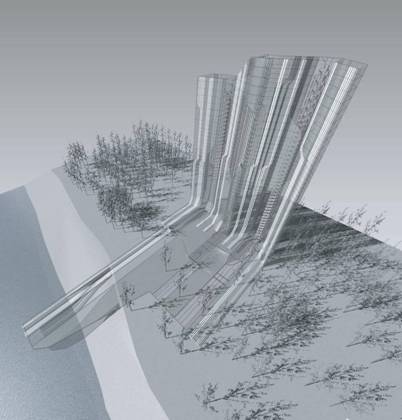
Apartment Tower, Moscow
2. Interface
The taller the tower, the more important becomes its mode of interfacing with the ground-plane. The large amount of traffic coming down from the tower usually occasions special spatial provisions on the ground-floor. For instance in the case of a hotel tower all additional facilities like lobbies, restaurants, bars, retail etc. are located on the ground-floor or near to the ground. Tall residential towers, as well as office towers, also demand ground-level expansion. Usually these additional space-requirements are catered for by means of discrete podium blocks that separate the shaft of the tower from the ground. One of our key ambitions has been to find convincing alternatives to the ‘tower on podium’ typology, alternatives that avoid the intervention of a discrete third element between the ground-surface and the tower itself.
The most simple concept here is to turn or bend the vertical extension into a horizontal extension. The most successful example of this simple move is perhaps our 40 storey apartment tower-slab in Moscow. The tall slab bends into the horizontal across its full width to produce ample space for the pool, fitness area, restaurant and retail. The degree to which this horizontal extension is perceived as direct extension of the body of the tower depends upon the specific continuities of surface treatment and fenestration patterns. The great canyon voids in the main façade turn to become linear sky-lights above the pool etc. Equally important are the nuances of the volumetric treatment. While the horizontal extension pulls out to the river-front and finally turns into a highly formalized landscape extension, at the opposite side (entrance side) the façade pulls inward in a responding countermove. Thus the tower dramatically overhangs the drop off zone, signalling where to slip into the building.
A similar move was specifying our residential towers for Beijing’s “Soho City”. As ‘tails’ are pulled out from the tower on one side, the opposite side reacts with pulling the envelope inward, thus clearly articulating the entrance. In this project we designed a whole swarm of towers. While the higher levels of the towers are repeated within one tower and across towers, the tops have been shaved off according to a global, curved envelope. The tails are all different, adapting to the local context and to each other. The tail-extension gives each tower a clear directionality which facilitates the establishment of the overall swarm logic of coordinated focus and directionality.
Our twin-tower proposal “Soho Forum” for a mixed use tower for Beijing’s CBD is flaring out at the bottom (bell-bottom) to accommodate retail. The flares of the two towers merge in a grand swoop to enclose even larger retail spaces.
Our tower for Milan is a twisted tower, whereby the twist continues the spiralling move of the shopping mall below. Here the typical linear atrium which marks the mall typology is continued and reinterpreted in the tower as split that moves up the whole height of the tower. This morphological affiliation helps to unify tower and ground extension.
Perhaps the most original and beautiful solution to the problem of how to interface with the ground-plane has been developed in connection with our competition entry for the Olympic village of the New York 2112 Olympic bid. Here the tower shaft tightens conically at the bottom, like a pencil, and dips/pierces into the “elastic” ground-surface. The ground-surface reacts like a water-surface with a crater and concentric ripples. This crater formation affords ample additional space within its flanks without obstructing or occluding the tower entrance. The tightened footprint of the tower contains nothing but lobby spaces grouped around the vertical circulation shaft (core). Moving between the towers is a pleasure with the ability to let the glance wonder up the pencil-tower or down into the crater-like clearing which contains all the public facilities.
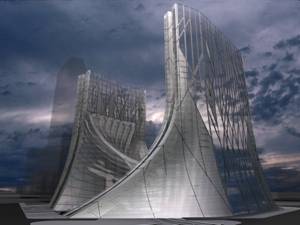
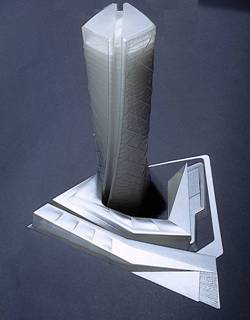
Soho Forum, Beijing CBD Shopping Mall and Office Tower, Milan
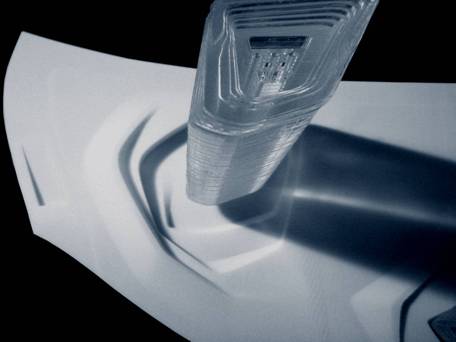
Olympic Village, NYC 2012
3. Navigation
The idea of explicitly introducing navigation as a key agenda to be considered in the design of towers goes hand in hand with the attempt to inject a certain measure of differentiation and complexity into the vertical trajectory of the tower. The repetition of the same does not require a special design effort to facilitate orientation. And usually the navigation of towers is dead simple: just step into the elevator and select the required floor. As the complexity of the tower increases and public functions start to penetrate the tower, navigation becomes an issue. And by navigation we mean much more than mere mechanical circulation. We mean the conceptual/perceptual penetration of a space. A legibly configured navigation space is called for that affords a certain visual penetration and mental map. Floors are no longer segregated black boxes. Such a space invites browsing rather than mere destination travel.
We first developed this notion of the navigation space with respect to our more complex museum designs – especially in relation to our Rome museum. The Cincinnati Contemporary Arts Centre displays our first vertical navigation space. Here we created a continuous sliver space with a cascade of stair-ramps in the back of the stack of different gallery volumes.
Our concept for a new Guggenheim Museum in Singapore proposed a tower which was also marked by a dramatic internal navigation space with super-tall lobby and tall sky-lobby above the mid-level.
In the case of our twin-towers for Beijing’s CBD the flaring of the towers opened up a a tent-shaped atrium space on the inside which indicates the gradient of penetration of the public into the higher floors of the tower, until the void closes down to separate off the fully private floors.
The Moscow apartment tower is sliced by three independent navigation spaces. This tower is designed without corridors. Instead it has three independent cores rising up. However, the cores - usually the most solid elements of a tower - are interpreted as canyon-shaped voids that slice all the way through the volume. The elevators are turned into transparent glass elevators and the staircases are treated like open stairs instead of closed shafts. The canyon narrows and widens as we move up the building. The arrival at the doorstep of the apartments is a fantastic panoramic journey.
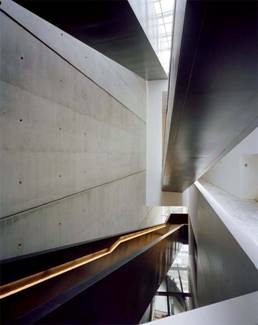
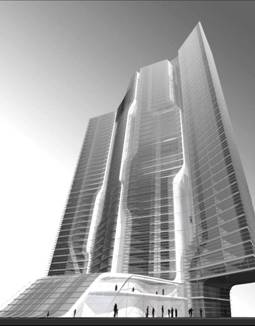
Contemporary Art Centre, Cincinatti Apartment Tower, Moscow
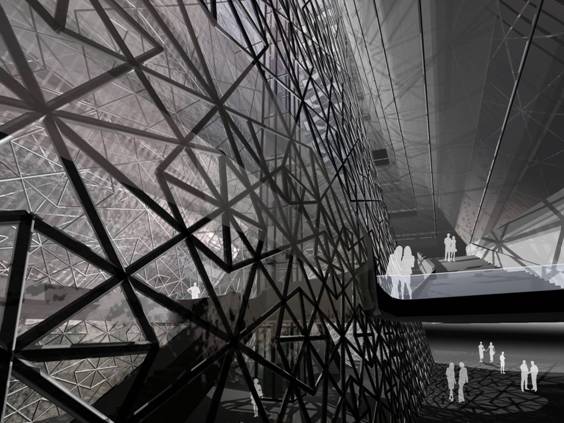
Soho Forum, Beijing CBD
Conclusion:
The agendas of differentiation, interface and navigation combine to articulate a new paradigm for the design of complex towers in urban contexts. On this new basis the tower typology will receive a new lease of life in the central metropolitan societies, where the desire for connectivity (rather than pure quantity) drives urban density. In the future, even more than is evident already now, this super-dense build up will be a mixed-use build up, where multiple life-processes intersect. These life-processes need to be ordered in intricate ways that nevertheless remain legible. More than ever, the task of architectural design will be about the transparent articulation of relations for the sake of orientation and communication. The differentiation, interfacing and navigation of spaces is stated as a clear agenda that will require a sophisticated, versatile language of architecture to be articulated in all its forms and contexts.
Patrik Schumacher, London 2006
Published in:
Zaha Hadid: 2006 The Solomon R. Guggenheim Foundation, New York
back to WRITINGS













